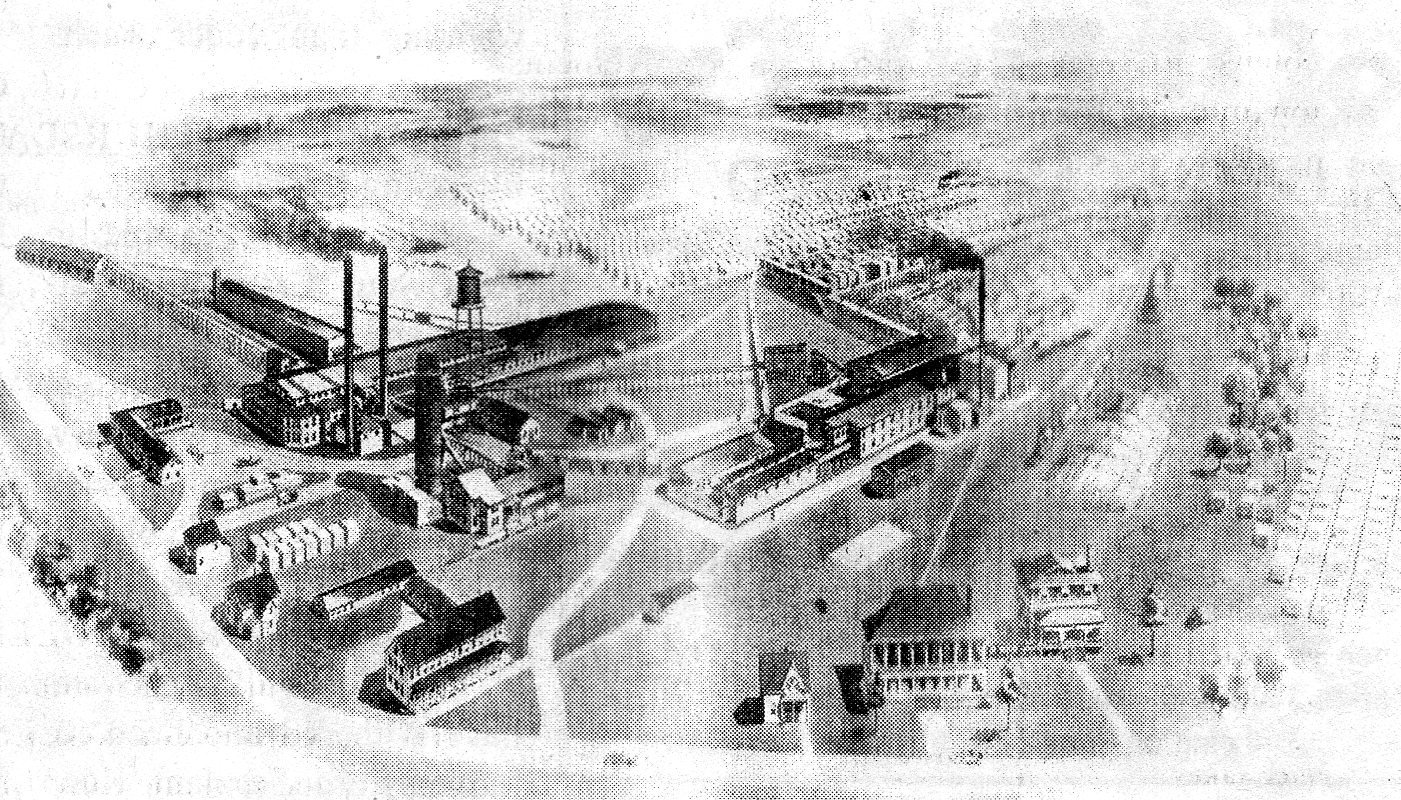
Part II
Submitted by Nute Chapman
From Onaway Outlook March 15, 2013

 |
Part II Submitted by Nute Chapman From Onaway Outlook March 15, 2013 |
 |
CAPTION #1: THIS WEEK'S PICTURE shows the Huron Handle Company and the Lobdell and Bailey
Manufacturing Company. The company office and dining hall are on the bottom right of this picture.
The office building still stands today and is our new museum. This building had been the Masonic Temple
for many years.(Courtesy photo)
 The percentage of straight-grain maple suitable for bicycle wood rim strips for each 1,000 feet of lumber
cut, did not exceed from 12 to 15 percent. Therefore it was necessary to install a large woodworking
manufacturing plant to work up the balance of the lumber after selecting the wood rim stock from it. It
required 20,000,000 feet of hard maple to select a sufficient quantity of straight-grain maple strips to supply
the trade of The American Wood Rim Company in the United States.
The percentage of straight-grain maple suitable for bicycle wood rim strips for each 1,000 feet of lumber
cut, did not exceed from 12 to 15 percent. Therefore it was necessary to install a large woodworking
manufacturing plant to work up the balance of the lumber after selecting the wood rim stock from it. It
required 20,000,000 feet of hard maple to select a sufficient quantity of straight-grain maple strips to supply
the trade of The American Wood Rim Company in the United States.
The American Wood Rim Company was able to produce the high grade fine quality finish of wood rims at reasonable
prices because they have to did not pay freight on raw material, the same being at their door. There was also no
fuel expense to run their 1,250 horse power wood rim plant owing to the reuse of waste from their large saw mill
and woodwork manufacturing plant, and because of their overhead being at a minimum cost owing to the selling force
and the office force of both companies being combined.
The price of raw material for bicycle wood rims had advanced 40 percent in five years, but The American
Wood Rim Company stockholders owning a large acreage of standing hard maple timber were protected in their
supply for the next 12 to 15 years to come.
The rock maple forests at the time were controlled and owned by a very few large lumber concerns, and the
finest quality of hard rock maple is in the northern half of the southern peninsula of Michigan. The use of
this wood has increased very rapidly over the course of 10 years for other manufacturing purposed and without
this production of raw material The American Wood Rim Company would be unable to manufacture the large output
which they were furnishing to the bicycle manufacturers and jobbers and the automobile manufacturers.
LOBDELL BICYCLE WOOD RIMS
The wood rims on the bicycle have doubtless received scant consideration and this article was an endeavor
to show just what constitutes a good, serviceable rim.
In the first place, a rim must be made of correct material and by proper methods to stand up under hard
work it is subjected to.
Lobdell Rims had a reputation as the best rims made.
In the old days they were made from second-growth hickory, but when this material was exhausted, something
else had to be used. Straight-grained maple was the best material known to the lumber industry for making
bicycle wood rims. It was the most expensive maple cut.
We do not believe any other rim manufacturer in this country used as good as material or as careful and thorough
methods in producing rims as The American Wood Rim Company.
MATERIAL USED IN LOBDELL RIMS
Lobdell Rims were made from straight-grain maple and as one of the largest hard-wood manufacturers in the state
of Michigan, the rim strips were selected from a cut of over 20,000,000 feet of maple lumber each year, these being
from 12 to 15 percent of straight-grain stock suitable for our grade of rim strips, out of this large production
of lumber.
The rim material was cured out of doors, and today we have in our yard $150,000 worth of this selected
straight-grain material, which was air-dried 10 months or more before using, ready to make up into rims to the
customers' requirements.
This material had advanced in price $8.50 per thousand, which added just so much extra cost to each rim. Regardless
of this advance, Lobdell Rims continued to be made of this material and at the same price as heretofore.
This selected straight-grain maple lumber steadily advanced in price from year to year, however, the extensive
production enables them to use this selected stock exclusively in Lobdell Rims.
PROCESS OF MANUFACTURE
After the strips were thoroughly air-dried, they were cut to proper length, placed in a steel drum, closed airtight,
and then hot steam was turned into it to soften the strips ready for bending.
The strips were then bent and in the bending process the grain of the strip was compressed by end pressure, which
does not stretch the outside grain of the strip, thereby toughening the fiber of the wood very materially and this also
eliminates any liability to split.
This process was adopted and used by the most skillful and scientific wood benders in the United States, and was the
only correct process at the time for bending wood so it retains its full strength, resiliency and lasting qualities.
-From The Onaway Outlook, March 15, 2013, p. 3.
Retyped by J. Anderson.